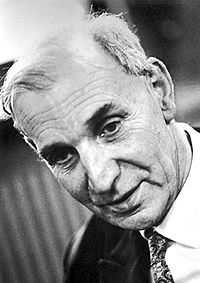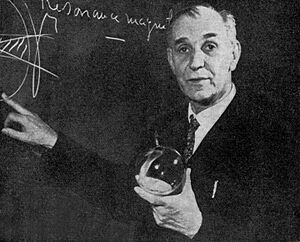Alfred Kastler facts for kids
Quick facts for kids
Alfred Kastler
|
|
|---|---|

Alfred Kastler
|
|
| Born | 3 May 1902 |
| Died | 7 January 1984 (aged 81) Bandol, France
|
| Nationality | France |
| Alma mater | École Normale Supérieure, University of Paris |
| Known for | Optical pumping technique |
| Awards | Holweck Prize (1954), CNRS Gold medal (1964), Nobel Prize for Physics (1966) |
| Scientific career | |
| Fields | physics |
| Doctoral advisor | Pierre Daure |
| Doctoral students | Claude Cohen Tannoudji |
Alfred Kastler (born May 3, 1902 – died January 7, 1984) was a famous French physicist. He won the Nobel Prize in 1966 for his important discoveries. His work helped us understand how light and atoms interact.
Biography
Alfred Kastler was born in Guebwiller, a town in Alsace, which was part of the German Empire at the time. He went to school in Colmar and later studied at the École normale supérieure in Paris in 1921.
After finishing his studies in 1926, he started teaching physics. He taught at a high school in Mulhouse and then became a professor at the University of Bordeaux. In 1941, he returned to the École Normale Supérieure, where he became a full professor in 1952.
His Discoveries
Kastler worked with another scientist, Jean Brossel. They studied quantum mechanics, which is about how tiny particles behave. They also looked at how light and atoms interact. This led them to develop a special method called "optical pumping".
Optical pumping uses light to change the energy levels of atoms. This technique was very important. It helped scientists understand and create lasers and masers. Lasers are used in many things today, like DVD players, barcode scanners, and even surgery.
Nobel Prize and Other Work
In 1966, Alfred Kastler received the Nobel Prize in Physics. He won it for discovering and developing the optical pumping method. This method allowed scientists to study how atoms respond to radio waves using light.
Besides his scientific work, Kastler was also involved in other important activities. He was the first chairman of Action Against Hunger, an organization that helps people who don't have enough food. He also enjoyed writing poetry in German. In 1971, he published a book of his poems.
Laboratoire Kastler-Brossel
Professor Kastler spent most of his research time at the Ecole Normale Supérieure in Paris. After World War II, he started a small research group there with his student, Jean Brossel. They focused on spectroscopy, which is the study of how matter interacts with light.
Over the next 40 years, this group became very important. It trained many young physicists and greatly helped the study of atomic physics in France. In 1994, the lab was renamed Laboratoire Kastler-Brossel in honor of Alfred Kastler and Jean Brossel. Today, parts of the lab are at the Université Pierre et Marie Curie and the École normale supérieure.
Alfred Kastler passed away on January 7, 1984, in Bandol, France.
See also
 In Spanish: Alfred Kastler para niños
In Spanish: Alfred Kastler para niños


